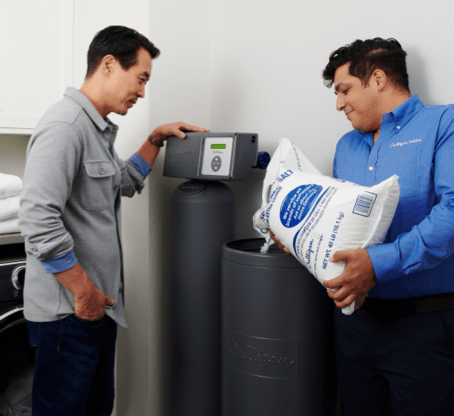
When To Put Salt in Water Softener Systems
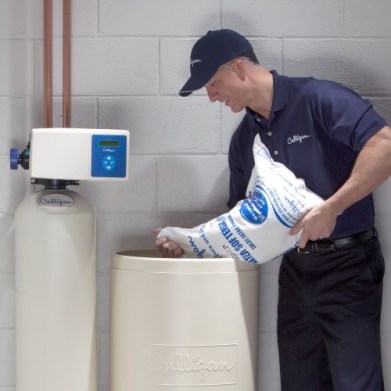
Water softeners use salt to help flush away the hard water minerals responsible for issues like limescale, dry skin and hair, spotty dishes and more. To keep your water hardness level down and get the most out of your softener system, experts recommend checking the brine tank at least once a month and adding salt whenever it’s less than half full.
However, the ideal schedule for putting salt in your water softener can depend on the system, your water hardness and more. Here’s what to know and how to ensure you get consistently soft water for years to come.
Tips for Adding Water Softener Salt
Checking salt levels is one of the few responsibilities you have when it comes to water softener maintenance. Fortunately, this doesn’t add much to your to-do list. Here are a few helpful tips for monitoring and adding softener salt:
How Often Should You Add Salt?
Although checking the salt tank once a month is a good starting point, it’s not a hard and fast rule for every system. That’s because salt replacement depends on a water softening process called regeneration.
Water softeners use resin beads to trap hard water minerals like calcium and magnesium. When these beads become “full,” the softener regenerates using a brine solution to rinse the minerals away so the resin can stay effective. Basic models may run this process more frequently, while more advanced systems may include salt level monitors and regenerate more efficiently based on demand.
Simply put, the more often your softener regenerates, the more often you’ll need to add salt.
How Much Salt Should You Add?
The right amount of salt depends on your softener, how often it regenerates and how big your brine tank is. Your goal is to keep the tank about half full while ensuring the salt is above the water level, which means adding salt as necessary without overfilling. Check your user’s guide or manual for specifics on ideal levels.
What Happens if the Salt Runs Out?
If your softener runs out of salt, it’s not the end of the world. You’ll just notice that your hard water problems are coming back because the system may not be able to soften and regenerate properly. This is also why you should check your salt levels first whenever you suspect a problem with your system, like if the softener is full of water.
Why Is It Important To Pay Attention to the Salt Level?
Adding more salt to your water softener’s brine tank as needed allows the regeneration process to proceed effectively. An adequate salt supply produces an appropriate brine solution for rinsing the resin beads. This, in turn, keeps your water softening system working efficiently and effectively while protecting its lifespan.
Getting The Right Kind of Water Softener Salt
Topping off your water softener’s brine tank on time shouldn’t be a hassle. However, there’s one remaining question, and that’s about the kind of salt necessary for your specific system. The problem is that it’s easy to forget the specifics of brand and variety, especially if you don’t have a routine for salt replacement. Scrambling around the store at the last minute can leave you more susceptible to picking up the wrong 40-pound bag, and that’s a heavy mistake.
Here’s what to know about different kinds of softener salt:
Chemical Composition of Water Softener Salt Varieties
Common salt, or sodium chloride, is the most frequently used substance for water softeners. Systems can use alternatives like potassium chloride, although this is a more expensive and less efficient choice. To decide which is best for your needs, consider your personal preferences and the capabilities of your water softener.
Water Softener Salt Forms
There are various types of water softener salt, from crystals and rock salt to high-quality salt pellets. Solar salt is the most common option. Purer forms, like pellets, may help keep your brine tank cleaner. You might also consider varieties formulated to help fight iron buildup and related problems within your water softening system and throughout your home. If you’re working with a water softening partner like Culligan, they will recommend the right salt for your system.
Making sure that you regularly refill your brine tank will help you keep your preferred salt in mind the next time you’re at the store. Even better, using a water softener salt delivery service offers added convenience. Once you place your order, your provider will deliver your preferred water softener salt according to an agreed-upon schedule. You won’t even have to lug the bag home on your own.
What Are Water Softener Maintenance Checks?
When you stick to a timely schedule for refilling your brine tank, you also get regular opportunities to ensure everything is working smoothly. The good news is that a water softener system doesn’t demand much in the way of maintenance — and if you do notice bigger problems, it’s usually best to let the experts handle them. Professional salt delivery services can be bundled with additional support from skilled technicians who can help you get the highest performance possible from your water softener.
Even with the best service on your side, it’s still helpful to know what to look out for. Here’s what to add to your water softener maintenance checks:
Handling Salt Bridges and Mushing
As you inspect your brine tank to decide whether you need to add more salt, be on the lookout for signs of salt bridging and mushing.
- Bridging: A salt bridge is most likely to happen with solar salt. It occurs when salt in the brine tank cakes or otherwise coagulates a large mass. It might make the tank look full, but the reality is that this mass is hiding an empty space underneath. This means your brine solution won’t achieve the proper salt concentration, preventing effective regeneration and potentially allowing hard water problems to return.
- Mushing: This issue is more likely to occur with pellet salt. Mushing can cause clogs at the bottom of the brine tank — opposite from bridging, which creates masses at the top. However, both problems will lead to poor regeneration, meaning that the system can’t create soft water.
Mushing and bridging require basic maintenance and some thorough cleaning to restore your water softener to peak operating condition. Monitoring for these issues as you replenish your brine tank’s salt supply regularly can help keep your water soft.
Knowing When It’s Time To Replace Your Water Softener
Regular maintenance will ensure your water softener lasts as long as possible — but no appliance works forever. Eventually, it will be time to replace your water softener. With a watchful eye on your brine tank’s salt supply, you’ll be able to quickly spot the signs that you may want to consider a new system.
If your water usage patterns remain stable but you find yourself refilling your brine tank more or less frequently (or not at all) as time goes on, the chances are high that the softener’s performance is declining. You might also start to notice increased maintenance needs, inconsistent water softness levels and other issues.
When your softener shows these signs of age, it’s smart to start researching replacements as soon as possible. That way, you can have a new system installed before the old one fails.
Fortunately, softener replacement is the perfect opportunity to upgrade. If you haven’t purchased a softener or any other water treatment system in some time, you might be surprised to see how many functions you can afford with a modern model. Here are just a few features to look for:
- Smart usage monitoring for salt
- Regeneration based on demand, not a set schedule
- Remote system diagnostics delivered to a service provider
- Salt delivery through your new partner
While it’s exciting to shop for upgrades, keep in mind that a softener must fit your unique needs. That means having a professional water test to determine your home’s water hardness level (and other potential quality issues). A local expert will use this information to make personalized recommendations for your ideal softener system.
Why You Need a Well-Maintained Water Softener
If you don’t replace your water softener salt on time, you’ll quickly start to remember why you wanted a softener in the first place. That’s because all the old hard water problems will start coming back, including:
Skin, Hair and Nail Issues
Hard water can impact your hair, skin and nails. When you bathe or wash your hands in water with a high concentration of hardness minerals, you may find it difficult to work up a lather and rinse the soap off completely. Additionally, hard water can leave your hair and skin feeling dry and cause your nails to become thin or discolored.
Cleaning Challenges
Ineffective cleaning is a hallmark of hard water. You may end up spending more money on soap and detergent, but because hardness makes these supplies less effective, you could still have trouble getting your home, dishes and clothes clean. You’ll also notice increased limescale the longer you use hard water, and this unpleasant mineral buildup can be difficult to remove from fixtures like faucets and handles.
Water Hardness and Damage to Water-Using Appliances
Water-using appliances like your washing machine or dishwasher may be negatively affected by mineral buildup in pipes and plumbing. You might notice issues like reduced water pressure or appliance performance — and over time, these systems might suffer longer-term damage impacting their longevity, or need costly repairs.
How To Keep Softened Water Flowing
If you want to avoid hard water issues and get the most out of your softener, it’s important to add salt at the correct intervals. However, finding the right type and amount can be a challenge. To keep the soft water flowing, learn about our salt delivery services and work on your personalized schedule today.
But what if your softener system isn’t functioning as well as it should? In that case, it might be time for an upgrade. Schedule your free, in-home water test and consultation to check your home’s water hardness levels and get custom recommendations for a softener upgrade.
Related Articles
How To Replace a Water Softener
8 min read
Find A Location Near Me

Schedule Your Free
In-Home Water Test
Get better water in your home by scheduling an appointment with your local Culligan Water Expert.
Discover More
See All Articles

How To Replace a Water Softener Salt Tank
Here are expert insights to answer your questions about water softener salt tank maintenance.
7 min read

Explore

Explore
Our Products
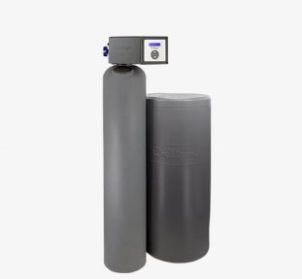
Water Softeners
With any of our soft water systems, get more out of your water-using appliances while spending less on energy and detergent.
View Products
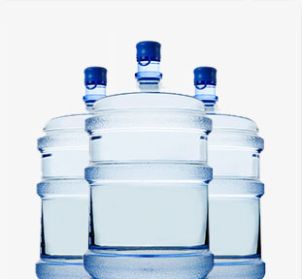
Water Delivery
There’s never been a better time to enjoy the convenience of scheduled bottled water deliveries from the Culligan® Water Experts
View Products
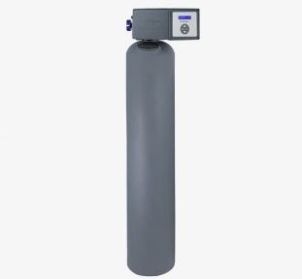
Water Filtration Systems
Culligan's water filtration systems have improved water quality for thousands of families worldwide.
View Products
